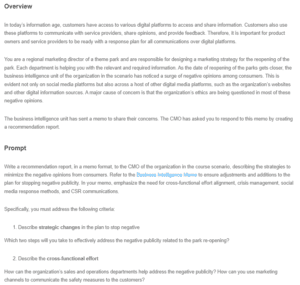Memo – Minimizing Negative Opinion from Consumers
To: The Chief Marketing Officer.
From: The Regional Marketing Director.
CC: Other recipients
Subject: Minimizing Negative Opinion from Consumers.
Greetings,
Addressing negative publicity in an organization requires that those responsible do not panic. The first strategy is to confront the source of negative publicity and prove them wrong (Matos & Veiga, 2005). It essentially requires the theme Park’s management to answer questions regarding safety and allegations of profit prioritization over customer satisfaction. Another strategy to reverse negative publicity is by making amends. Going above board to try and fix problems faced by Park users will show them that the company cares (Matos & Veiga, 2005). If there is major media attention on the issue, it is important to seek legal advice.
Cross-functional effort alignment requires people from different departments and functions to work together towards a common objective. Among other things, alignment involves eliminating silos that exist among different departments. For instance, the marketing team and safety teams ought to collaborate to eliminate the negative perception regarding the theme park.
A key communication strategy during business crises is to avoid controversial topics. It might be appealing to side with a section of customers who favor the business, but the Park management should avoid that route. There is a need to have a wide appeal by associating with people with different cultural aspects to avoid losing the party’s appeal (Forbes Agency Council, 2019). In any case, it would be prudent not to speak at all as the business addresses the issues raised.
Most of the complaints about the challenges at the park will be raised on social media. The management should address the issues as a team instead of acting as an individual (Forbes Agency Council, 2019). Besides, the management should leverage the company’s social media presence to stop the bleeding by owning up to the issues and laying bare the correction strategy. Finally, the management should embrace transparency while addressing the issue.
References
Forbes Agency Council. (2019, February 28). Council Post: How To Deal With Negative Press In A Positive Way. Forbes. https://www.forbes.com/sites/forbesagencycouncil/2019/02/28/how-to-deal-with-negative-press-in-a-positive-way/?sh=18c1d5d73d9e
Matos, C. A. de, & Veiga, R. T. (2005). How to deal with negative publicity: the importance of consumer involvement. Revista de Administração Contemporânea, 9(spe2), 47–62. https://doi.org/10.1590/s1415-65552005000600005
ORDER A PLAGIARISM-FREE PAPER HERE
We’ll write everything from scratch
Question

Minimizing Negative Opinion from Consumers
Overview
In today’s information age, customers have access to various digital platforms to access and share information. Customers also use these platforms to communicate with service providers, share opinions, and provide feedback. Therefore, it is important for product owners and service providers to be ready with a response plan for all communications over digital platforms.
You are a regional marketing director of a theme park and are responsible for designing a marketing strategy for the reopening of the park. Each department is helping you with the relevant and required information. As the date of reopening of the parks gets closer, the business intelligence unit of the organization in the scenario has noticed a surge of negative opinions among consumers. This is evident not only on social media platforms but also across a host of other digital media platforms, such as the organization’s websites and other digital information sources. A major cause of concern is that the organization’s ethics are being questioned in most of these negative opinions.
The business intelligence unit has sent a memo to share their concerns. The CMO has asked you to respond to this memo by creating a recommendation report.
Prompt
Write a recommendation report, in a memo format, to the CMO of the organization in the course scenario, describing the strategies to minimize the negative opinions from consumers. Refer to the Business Intelligence Memo to ensure adjustments and additions to the plan for stopping negative publicity. In your memo, emphasize the need for cross-functional effort alignment, crisis management, social media response methods, and CSR communications.
Specifically, you must address the following criteria:
- Describe strategic changes in the plan to stop negative
Which two steps will you take to effectively address the negative publicity related to the park re-opening?
- Describe the cross-functional effort
How can the organization’s sales and operations departments help address the negative publicity? How can you use marketing channels to communicate the safety measures to the customers?
- Explain how a crisis communication plan can improve the organization’s image when aligned with ethical How would you use your public relations efforts in crisis communication?
How would you use your corporate website for crisis communication?
- Describe the social media response methods to be used in this How would you address negative comments?
How would you answer the safety-related questions?
- Describe the corporate social responsibility (CSR) communications strategy in this What are the key CSR initiatives and policies for the organization?
What are the key channels for communicating CSR initiatives?

